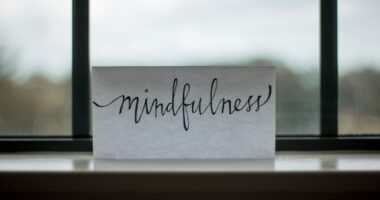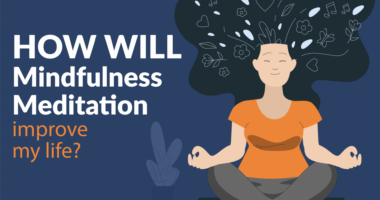Introduction: Anxiety is a common experience in today’s fast-paced world, often triggered by stress, uncertainty, and the demands of daily life. While anxiety can be challenging to manage, mindfulness practices offer effective tools for reducing its impact. This article explores ten mindfulness techniques that can help alleviate anxiety and promote a sense of calm and well-being.
1. Mindful Breathing: Mindful breathing is a foundational mindfulness practice that helps anchor you in the present moment. By focusing on your breath, you can create a sense of calm and reduce anxiety.
How to Practice:
- Find a comfortable position and close your eyes.
- Take a deep breath in through your nose, allowing your abdomen to rise.
- Exhale slowly through your mouth, letting go of any tension.
- Continue to breathe deeply, focusing on the sensation of your breath entering and leaving your body.
2. Body Scan Meditation: Body scan meditation involves bringing awareness to different parts of your body, helping you release tension and promote relaxation.
How to Practice:
- Lie down or sit in a comfortable position.
- Close your eyes and take a few deep breaths.
- Start at your toes and gradually move your attention up through your body, noticing any sensations or areas of tension.
- Breathe into each area, allowing it to soften and relax.
3. Mindful Walking: Mindful walking combines movement with mindfulness, helping you connect with your surroundings and reduce anxiety.
How to Practice:
- Find a quiet place to walk, either indoors or outdoors.
- Walk slowly and deliberately, paying attention to the sensation of your feet touching the ground.
- Notice the sights, sounds, and smells around you.
- If your mind wanders, gently bring your attention back to the act of walking.
4. Loving-Kindness Meditation: Loving-kindness meditation, also known as Metta meditation, involves sending goodwill and compassion to yourself and others. This practice can help reduce anxiety by fostering positive emotions.
How to Practice:
- Sit in a comfortable position and close your eyes.
- Begin by silently repeating phrases of kindness to yourself, such as “May I be happy, may I be healthy, may I be safe.”
- Gradually extend these wishes to others, including loved ones, acquaintances, and even those you have conflicts with.
- End the meditation by sending loving-kindness to all beings.
5. Mindful Eating: Mindful eating involves paying full attention to the experience of eating, helping you develop a healthier relationship with food and reduce anxiety related to eating habits.
How to Practice:
- Choose a meal or snack and eliminate distractions, such as TV or phones.
- Take a moment to appreciate the appearance, smell, and texture of the food.
- Eat slowly, savoring each bite and noticing the flavors and sensations.
- Pay attention to your body’s hunger and fullness cues.
6. Progressive Muscle Relaxation: Progressive muscle relaxation involves tensing and then relaxing different muscle groups, promoting physical and mental relaxation.
How to Practice:
- Sit or lie down in a comfortable position.
- Starting with your feet, tense the muscles for a few seconds, then release.
- Move up through your body, tensing and relaxing each muscle group, including your legs, abdomen, arms, and face.
- Notice the difference between tension and relaxation.
7. Guided Imagery: Guided imagery involves using your imagination to create calming and positive mental images, helping to reduce anxiety and promote relaxation.
How to Practice:
- Find a quiet place to sit or lie down and close your eyes.
- Take a few deep breaths to relax.
- Visualize a peaceful place, such as a beach, forest, or meadow.
- Engage all your senses, imagining the sights, sounds, smells, and feelings associated with this place.
- Spend several minutes immersed in this calming environment.
8. Mindful Journaling: Mindful journaling involves writing down your thoughts and feelings with awareness and without judgment. This practice can help you process emotions and reduce anxiety.
How to Practice:
- Set aside a few minutes each day to write in a journal.
- Focus on your current thoughts, feelings, and experiences.
- Write freely without worrying about grammar or structure.
- Reflect on what you’ve written and notice any patterns or insights.
9. Mindfulness Apps: There are many mindfulness apps available that offer guided meditations, breathing exercises, and other mindfulness practices to help reduce anxiety.
Popular Apps:
- Headspace: Offers guided meditations and mindfulness exercises for stress and anxiety.
- Calm: Provides a variety of meditation sessions, sleep stories, and relaxation techniques.
- Insight Timer: Features a large library of guided meditations and mindfulness practices from various teachers.
10. Daily Mindfulness Moments: Incorporating mindfulness into your daily routine can help you manage anxiety on an ongoing basis. These moments of mindfulness can be brief but impactful.
How to Practice:
- Set reminders on your phone to take a few mindful breaths throughout the day.
- Practice mindfulness during routine activities, such as brushing your teeth, washing dishes, or commuting.
- Use moments of waiting, such as standing in line or waiting for an appointment, to practice mindful breathing or body awareness.
Conclusion: Mindfulness practices offer effective tools for reducing anxiety and promoting a sense of calm and well-being. By incorporating techniques such as mindful breathing, body scan meditation, mindful walking, and loving-kindness meditation into your daily routine, you can manage anxiety more effectively and cultivate a greater sense of peace. Start with one or two practices that resonate with you and gradually build your mindfulness toolkit. Remember, consistency is key, and even small moments of mindfulness can make a significant difference in reducing anxiety and enhancing your overall quality of life.









